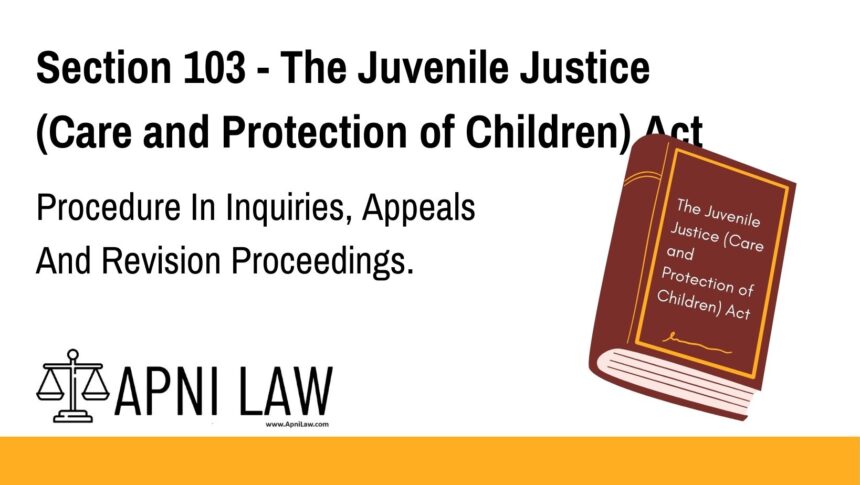Code: Section 103 of the Juvenile Justice (Care and Protection of Children) Act
Procedure in Inquiries, Appeals, and Revision Proceedings:
(1) Save as otherwise expressly provided by this Act, a Committee or a Board while holding any inquiry under any of the provisions of this Act, shall follow such procedure as may be prescribed and subject thereto, shall follow, as far as may be, the procedure laid down in the Code of Criminal Procedure, 1973 (2 of 1974) for trial of summons cases.
(2) Save as otherwise expressly provided by or under this Act, the procedure to be followed in hearing appeals or revision proceedings under this Act shall be, as far as practicable, in accordance with the provisions of the Code of Criminal Procedure, 1973 (2 of 1974).
Explanation of Section 103
Section 103 provides the guidelines for how inquiries, appeals, and revision proceedings should be conducted under the Juvenile Justice (Care and Protection of Children) Act.
Key Points:
- Inquiries: When the Juvenile Justice Committee or Board conducts an inquiry, they must follow a prescribed procedure. This procedure is generally in line with the Code of Criminal Procedure, 1973 (CrPC), especially for the trial of summons cases.
- Appeals & Revisions: The procedures for appeals or revision proceedings should be, as far as possible, in accordance with the CrPC, unless otherwise specified by the Juvenile Justice Act itself.
- Flexibility: While the CrPC forms the basis for these procedures, the Juvenile Justice Act allows for some flexibility in how inquiries, appeals, and revisions are carried out to best address the needs of children.
Illustration
Example 1: Juvenile Justice Inquiry
A Juvenile Justice Board is tasked with an inquiry into a child’s involvement in an offense. The Board follows the procedure laid out under Section 103, which aligns with the CrPC, ensuring a fair trial process, but adapted to consider the child’s best interests.
Example 2: Appeal Against a Decision
If a child’s guardian is dissatisfied with an order made by a Juvenile Justice Committee, they may appeal the decision. The appeal will follow the procedure of the CrPC, allowing for a structured and transparent review, ensuring that the child’s rights are protected during the process.
Example 3: Revision of a Juvenile Justice Order
A child is sentenced to detention under a Juvenile Justice Board’s order, but their legal guardian believes the decision was unjust. The guardian may file for revision, and the procedure followed in the revision process will mirror the CrPC, ensuring the child receives a fair opportunity for reconsideration.
Common Questions and Answers on Section 103
1. What is the significance of Section 103 in the Juvenile Justice Act?
Section 103 ensures that the procedures for inquiries, appeals, and revision proceedings under the Juvenile Justice Act are transparent and fair, aligning them with the established principles in the Code of Criminal Procedure, 1973, while taking the needs of children into account.
2. Can the Juvenile Justice Committee or Board ignore the CrPC while conducting inquiries?
No, the Juvenile Justice Act directs that, except for specific provisions, inquiries should follow the procedure laid down in the CrPC. However, there can be exceptions as expressly provided by the Juvenile Justice Act itself.
3. How do appeals and revision proceedings work under the Juvenile Justice Act?
Appeals and revisions under the Juvenile Justice Act should, as much as possible, follow the procedures outlined in the CrPC. However, the Act provides flexibility where necessary to protect the rights of the child and ensure that the process is fair and just.
4. Are there any exceptions to the CrPC procedures?
Yes, the Juvenile Justice Act provides specific exceptions where the CrPC procedures may not be applicable. For example, the Committee or Board may follow alternative procedures as prescribed under the Juvenile Justice Act.
5. Can children be subjected to the same trial procedures as adults under the CrPC?
No, while the Juvenile Justice Act draws from the CrPC, it ensures that the procedures are tailored to address the best interests of children, offering protections and adjustments as necessary for the age and needs of the child.
Conclusion
Section 103 of the Juvenile Justice Act ensures that the procedures for inquiries, appeals, and revisions under the Act align with the principles of fairness found in the CrPC. However, the Act also allows for flexibility, recognizing the need to prioritize the welfare and rights of children during these proceedings.
For further details on juvenile justice laws, visit ApniLaw today!








